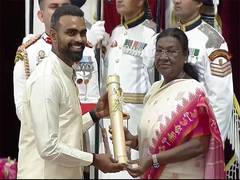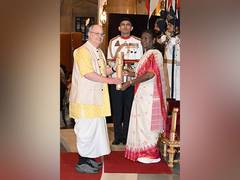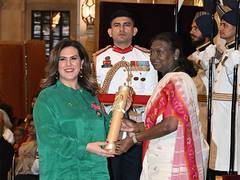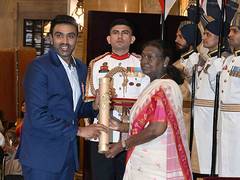How a mega performance at Kartavya Path helped artistes from different cultural backgrounds bond
New Delhi, Jan 26 (PTI) A motley group of 5,000 artistes drawn from different parts of the country performed 45 different dance forms on the full stretch of Kartavya Path on Sunday as part of Republic Day celebrations, and it wasn’t just rigorous practice, but the inter-cultural bonding among them that did the trick.
The nearly 11-minute ‘Jayati Jaya Mamah Bharatam’, curated by the Ministry of Culture, was one of the star attractions at the ceremonial parade, both due to its sheer scale and the richness of experience it offered to the spectators.
Like various streams of rivers, each group came from different states, bringing with them their own colour, costumes and culture, which all seemed to merge into one cohesive whole — “the colour of India”.
Such was the visual impact and synchronisation in performance that an official commentator at the ceremony even remarked that it felt like a ‘Kumbh’ of ‘Republic’ at the Kartavya Path, a ‘Sangam’ of different cultures.
Even after the parade ended, many guests sought to get clicked or take a selfie with the artistes dressed in vibrant costumes, reflecting the sartorial heritage of the region they represented.
From Himachal Pradesh to Andhra Pradesh and Manipur to Gujarat, a ‘mini-India’ descended on the Kartavya Path, as artistes wearing traditional costumes performed like one big team.
The dance forms that were showcased included Jhijhiya (Bihar), Mayur Ras (Uttar Pradesh), Dangi (Gujarat), Lambadi (Telangana), Kabui (Manipur) and Chau (West Bengal), among others.
Albertsana Rajkumar, 25, and Langlen, 19, from the Manipur contingent shared how it took month-long practice and bit of cultural bonding to get the steps in sync.
“We felt great after the performance… We think we all did fine. The warmth shown by the people after the celebrations shows we did something good,” Rajkumar told PTI.
An architect by profession, the Manpuri artiste called dance his passion and said it was this performance that brought him to Delhi for the second time.
“We practised hard at the Pusa camp for a month, from morning till evening. Managing such a large crowd was difficult, so it was divided into various groups and each group had a choreographer,” Rajkumar told PTI as a group of admirers clicked selfies with Langlen, the young woman artiste.
Langlen said people were getting drawn to their colourful costumes, especially after the performance.
Asked if the opportunity to perform also gave them an occasion to bond with artistes representing different cultures, they both concurred: “Definitely.”
“We got to learn about the language and culture of other states through them and they in turn learnt about our state, which also helped in better coordination,” Langlen said.
Khushi Thakur, 22, and Deepak Sharma, 25, both from Sirmaur district in Himachal Pradesh, had a similar tale to share.
Thakur and her teammates performed ‘Naati’, a dance form typical to their home state.
They both sat along the roadside at the end of the parade, with Thakur’s vibrant costume and Sharma’s Sirmau headgear attracting eyeballs.
The 5,000 folk and tribal artistes brought their dance forms to life with their original and authentic costumes, jewellery, headgear, and traditional props like spears, swords and drums.
For the first time, the performance covered the entire Kartavya Path from Vijay Chowk and C-Hexagon to ensure that all the guests enjoy the same viewing experience.
The musical performance featured folk and tribal artistes representing youth power, artistic heritage and women empowerment drawn from the length and breadth of India, representing the varied tapestry of culture and diversity of India’s heritage, officials said.
Bhagirath Mahato, Rakesh Mahato and Chandi Kumar, a trio from Bokaro, performed Chau dance along with other members of a large contingent from Jharkhand.
Rakesh Mahato, a third-generation Chau artiste, said it is a tough art to practise but very engaging for the audience as it involves somersaults while wearing masks.
After the end of the parade, people wanted to get clicked with the trio while they waited for transport near the parade venue.
“We are happy to share our culture with people here. We also learnt abut other cultures, costumes and languages, which not only helped in coordination but also broadened our horizon,” Rakesh said.
The choreography celebrated the themes of ‘Viksit Bharat’, ‘Virasat Bhi Vikas Bhi’, and ‘Ek Bharat Shreshtha Bharat’.
The lyrics for the ‘Jayati Jaya Mamah Bharatam’ presentation were penned by Subhash Sehgal while the music was composed by Shankar Mahadevan.






